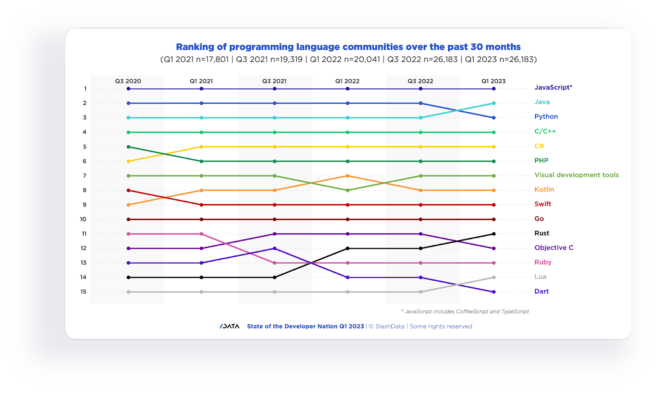With third-party APIs, developers can leverage the power of external expertise to enhance the functionality of their applications. However, to ensure success, they must carefully evaluate the quality of APIs before incorporating them into their applications. This chapter aims to investigate the key characteristics that make third-party APIs high-quality, according to developers.
In recent years, application programming interfaces (APIs) have become a key part of modern software development. APIs act as intermediaries that facilitate communication between different applications through established protocols and definitions. By using APIs, developers can leverage the power of other applications without needing custom integrations. In turn, this allows them to focus more on building the core parts of their applications and less on recreating features that already exist or are not feasible.
With this in mind, it is unsurprising that almost all developers (89%) report using APIs in their projects. According to our data, 74% of developers use third-party APIs while 15% state that they only use private or internal APIs. Using private/internal APIs makes it easier for developers to link their in-house applications together and ensures that only authorised personnel can access their systems and internal information. On the other hand, using third-party offerings gives them access to external expertise but introduces additional dependencies that can affect their projects.

74% of developers use third-party APIs
With so many developers relying on third-party APIs to expand the scope of their applications, modern services are becoming increasingly more likely to offer public APIs. However, not all APIs are created equal. Just as high-quality APIs can enhance the capabilities of a given application, adopting a low-quality API can be detrimental to its success. Implementing low-quality solutions can create a wide range of issues such as poor performance, negative user experience, and security vulnerabilities. Therefore, developers must carefully evaluate the quality of APIs before incorporating them into their applications.
In the latest edition of our global developer survey, we asked developers who use third-party APIs to identify the most important characteristics of high-quality API offerings. Our results indicate that developers consider security, documentation and sample code, reliability, ease of use, and performance to be the most important characteristics of high-quality APIs. These five qualities separate themselves from the rest as the core pillars of strength developers look for when considering third-party APIs. In fact, 89% of those who use third-party APIs mention at least one of these characteristics in association with high-quality APIs.
Security is the most important factor in evaluating the quality of third-party APIs, according to 42% of developers. Using third-party offerings opens up a line of communication with external services that can expose their users to unauthorised access to sensitive data and other security risks. To keep up with the rapidly evolving landscape of threats, developers and modern businesses must ensure that the APIs they use are secure to protect their assets.
Developers consider security to be the most important attribute of a high-quality API
Having access to clear documentation and sample code can make it substantially easier for developers to incorporate APIs into their applications. Our data suggest that 39% of developers consider documentation and sample code to be among the most important qualities in third-party APIs.
These features allow developers to quickly understand the capabilities and limitations that a given API brings and make it easier for them to get started. This goes hand in hand with ease of use, which is mentioned by 37% of developers who use third-party APIs.
On the other end of the spectrum, reliability (38%) and performance (36%) of third-party APIs can directly impact the success of a given project. If an API proves to be unreliable, it can lead to issues ranging from minor errors to system failures and data breaches.
On the other hand, reliable APIs help developers minimise the risk of something going wrong and ensure the highest chances of success in their projects. Similarly, applications can only perform as well as the APIs they use.
Therefore, it is essential for APIs to be fast and capable of handling high volumes of requests to be used in modern applications.

Those who are new to the field of software development tend to work on less challenging problems and can often turn to their peers and mentors for support. As such, they are the least likely (20%) to cite documentation and sample code as an important characteristic of a high-quality API and tend to prioritise other features.
However, as they gain expertise and take on more complex projects, developers begin to appreciate the benefits that clear documentation and sample code bring to the table. In fact, 65% of developers with 16+ years of experience mention documentation and sample code among the most important characteristics of high-quality third-party APIs, surpassing even security (51%).
Highly experienced developers value API documentation and sample code significantly more than beginners
With a greater reliance on self-guided learning, experienced developers become less likely to focus on the community when evaluating the quality of third-party APIs. However, technical issues can arise regardless of experience and may be difficult to resolve or diagnose without expert-level knowledge. In turn, technical support appears to retain its above-average importance for all but the most experienced developers.

With more years of experience, developers gain a deeper understanding of what is essential for their projects. For some, performance may be critical, while others may focus more on ease of use. By focusing on the right characteristics of third-party APIs, developers can enhance the functionality of their applications and deliver better products.
Would you like to contribute to similar findings?
Participate in our latest wave of the Developer Nation survey!
Complete the survey to access our amazing virtual Goody Bag filled with subscriptions, resources, and more!
Sign up for the chance to win prizes, earn loyalty points, and receive updates on survey results and future opportunities.
Take the survey anonymously here
















